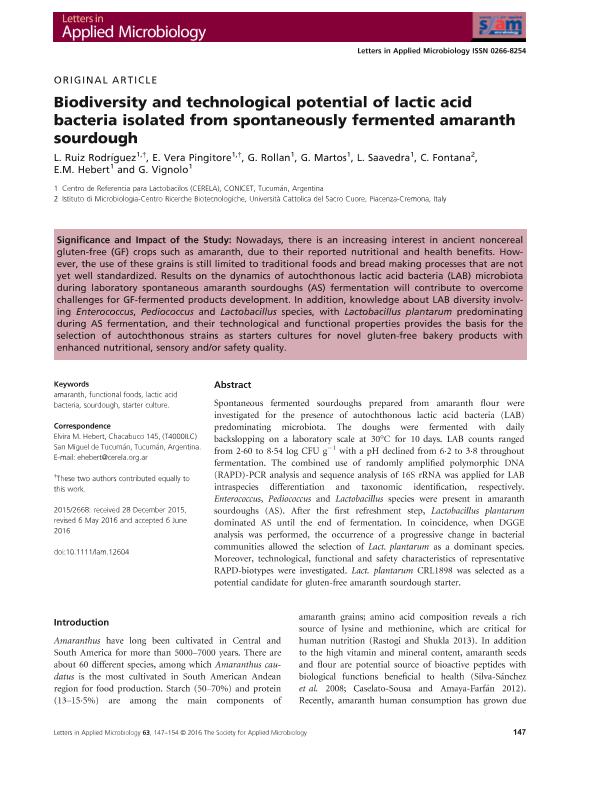Mostrar el registro sencillo del ítem
dc.contributor.author
Ruiz Rodríguez, Luciana Gabriela

dc.contributor.author
Vera Pingitore, Esteban

dc.contributor.author
Rollan, Graciela Celestina

dc.contributor.author
Martos, Gladys Irma

dc.contributor.author
Saavedra, Maria Lucila

dc.contributor.author
Fontana, Cecilia Alejandra

dc.contributor.author
Hebert, Elvira Maria

dc.contributor.author
Vignolo, Graciela Margarita

dc.date.available
2018-09-06T15:05:30Z
dc.date.issued
2016-08-09
dc.identifier.citation
Ruiz Rodríguez, Luciana Gabriela; Vera Pingitore, Esteban; Rollan, Graciela Celestina; Martos, Gladys Irma; Saavedra, Maria Lucila; et al.; Biodiversity and technological potential of lactic acid bacteria isolated from spontaneously fermented amaranth sourdough; Wiley Blackwell Publishing, Inc; Letters in Applied Microbiology; 63; 2; 9-8-2016; 147-154
dc.identifier.issn
0266-8254
dc.identifier.uri
http://hdl.handle.net/11336/58508
dc.description.abstract
Spontaneous fermented sourdoughs prepared from amaranth flour were investigated for the presence of autochthonous lactic acid bacteria (LAB) predominating microbiota. The doughs were fermented with daily backslopping on a laboratory scale at 30°C for 10 days. LAB counts ranged from 2·60 to 8·54 log CFU g−1 with a pH declined from 6·2 to 3·8 throughout fermentation. The combined use of randomly amplified polymorphic DNA (RAPD)-PCR analysis and sequence analysis of 16S rRNA was applied for LAB intraspecies differentiation and taxonomic identification, respectively. Enterococcus, Pediococcus and Lactobacillus species were present in amaranth sourdoughs (AS). After the first refreshment step, Lactobacillus plantarum dominated AS until the end of fermentation. In coincidence, when DGGE analysis was performed, the occurrence of a progressive change in bacterial communities allowed the selection of Lact. plantarum as a dominant species. Moreover, technological, functional and safety characteristics of representative RAPD-biotypes were investigated. Lact. plantarum CRL1898 was selected as a potential candidate for gluten-free amaranth sourdough starter. Significance and Impact of the Study: Nowadays, there is an increasing interest in ancient noncereal gluten-free (GF) crops such as amaranth, due to their reported nutritional and health benefits. However, the use of these grains is still limited to traditional foods and bread making processes that are not yet well standardized. Results on the dynamics of autochthonous lactic acid bacteria (LAB) microbiota during laboratory spontaneous amaranth sourdoughs (AS) fermentation will contribute to overcome challenges for GF-fermented products development. In addition, knowledge about LAB diversity involving Enterococcus, Pediococcus and Lactobacillus species, with Lactobacillus plantarum predominating during AS fermentation, and their technological and functional properties provides the basis for the selection of autochthonous strains as starters cultures for novel gluten-free bakery products with enhanced nutritional, sensory and/or safety quality.
dc.format
application/pdf
dc.language.iso
eng
dc.publisher
Wiley Blackwell Publishing, Inc

dc.rights
info:eu-repo/semantics/openAccess
dc.rights.uri
https://creativecommons.org/licenses/by-nc-sa/2.5/ar/
dc.subject
Amaranth
dc.subject
Functional Foods
dc.subject
Lactic Acid Bacteria
dc.subject
Sourdough
dc.subject
Starter Culture
dc.subject.classification
Alimentos y Bebidas

dc.subject.classification
Otras Ingenierías y Tecnologías

dc.subject.classification
INGENIERÍAS Y TECNOLOGÍAS

dc.title
Biodiversity and technological potential of lactic acid bacteria isolated from spontaneously fermented amaranth sourdough
dc.type
info:eu-repo/semantics/article
dc.type
info:ar-repo/semantics/artículo
dc.type
info:eu-repo/semantics/publishedVersion
dc.date.updated
2018-03-21T16:55:16Z
dc.identifier.eissn
1472-765X
dc.journal.volume
63
dc.journal.number
2
dc.journal.pagination
147-154
dc.journal.pais
Reino Unido

dc.journal.ciudad
Londres
dc.description.fil
Fil: Ruiz Rodríguez, Luciana Gabriela. Consejo Nacional de Investigaciones Científicas y Técnicas. Centro Científico Tecnológico Conicet - Tucuman. Centro de Referencia Para Lactobacilos; Argentina
dc.description.fil
Fil: Vera Pingitore, Esteban. Consejo Nacional de Investigaciones Científicas y Técnicas. Centro Científico Tecnológico Conicet - Tucuman. Centro de Referencia Para Lactobacilos; Argentina
dc.description.fil
Fil: Rollan, Graciela Celestina. Consejo Nacional de Investigaciones Científicas y Técnicas. Centro Científico Tecnológico Conicet - Tucuman. Centro de Referencia Para Lactobacilos; Argentina
dc.description.fil
Fil: Martos, Gladys Irma. Consejo Nacional de Investigaciones Científicas y Técnicas. Centro Científico Tecnológico Conicet - Tucumán. Centro de Referencia para Lactobacilos; Argentina
dc.description.fil
Fil: Saavedra, Maria Lucila. Consejo Nacional de Investigaciones Científicas y Técnicas. Centro Científico Tecnológico Conicet - Tucuman. Centro de Referencia Para Lactobacilos; Argentina
dc.description.fil
Fil: Fontana, Cecilia Alejandra. Università Cattolica del Sacro Cuore; Italia
dc.description.fil
Fil: Hebert, Elvira Maria. Consejo Nacional de Investigaciones Científicas y Técnicas. Centro Científico Tecnológico Conicet - Tucuman. Centro de Referencia Para Lactobacilos; Argentina
dc.description.fil
Fil: Vignolo, Graciela Margarita. Consejo Nacional de Investigaciones Científicas y Técnicas. Centro Científico Tecnológico Conicet - Tucuman. Centro de Referencia Para Lactobacilos; Argentina
dc.journal.title
Letters in Applied Microbiology

dc.relation.alternativeid
info:eu-repo/semantics/altIdentifier/url/http://onlinelibrary.wiley.com/doi/10.1111/lam.12604
dc.relation.alternativeid
info:eu-repo/semantics/altIdentifier/doi/http://dx.doi.org/10.1111/lam.12604
Archivos asociados
